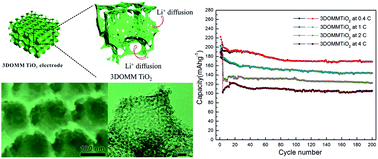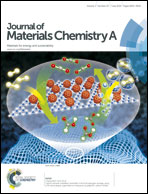Design of new anode materials based on hierarchical, three dimensional ordered macro-mesoporous TiO2 for high performance lithium ion batteries
Abstract
As anode materials for lithium ion batteries, two three dimensionally ordered macroporous TiO2, one with disordered inter-particle mesopores formed by the aggregation of nanoparticles (3DOM) and another with inner-particle mesopores generated by a surfactant templating strategy (3DOMM), have been synthesized using poly(styrene-methyl methacrylate-3-sulfopropyl methacrylate potassium) (P(St-MMA-SPMAP)) spheres as a hard template and their electrochemical properties are compared. SEM and TEM observations reveal that both 3DOM TiO2 and 3DOMM TiO2 have well-ordered macropores and interconnected macropore walls with a regular periodicity. 3DOMM TiO2 demonstrates a specific surface area of 139 m2 g−1, which is higher than that of 3DOM TiO2 (99 m2 g−1) due to the smaller crystallite size and inner-particle mesopores. The electrolyte adsorption results show that both 3DOM TiO2 and 3DOMM TiO2 have similar adsorption capacities despite a difference in the surface area. Electrochemical impendence spectroscopy analysis shows that 3DOMM TiO2 has a lower charge transfer resistance and faster Li+ diffusion coefficient than 3DOM TiO2. Moreover, both 3DOM TiO2 and 3DOMM TiO2 possess excellent initial capacity of 248 mA h g−1 and 235 mA h g−1 at 0.2 C and 208 mA h g−1 and 202 mA h g−1 at 1 C, respectively. The reversibility study demonstrates that the 3DOMM TiO2 displays higher cycling capacity, superior rate behavior and higher Coulombic efficiency because the higher surface area provides more active sites and the presence of the inner-particle mesopores in the walls of macropores serve as a bicontinuous transport path and affords a shorter path length for diffusion of Li ions compared with the 3DOM TiO2 and its crystallite aggregated mesopores. The reversible capacity of 106 mA h g−1 observed for the 3DOMM TiO2 can be retained after 200 charge–discharge cycles at a relatively high current rate of 4 C. This cycle stability performance can be equally attributed to the crystallite size and inner-particle mesopores in the 3DOMM TiO2. Moreover, the existence of a bicontinuous porous structure in the 3DOMM TiO2 can further enhance the lithium insertion/extraction capacity at high rates. We believe that this study can shed light on the 3DOMM structure as a promising material for highly enhanced performance in lithium ion batteries.


 Please wait while we load your content...
Please wait while we load your content...